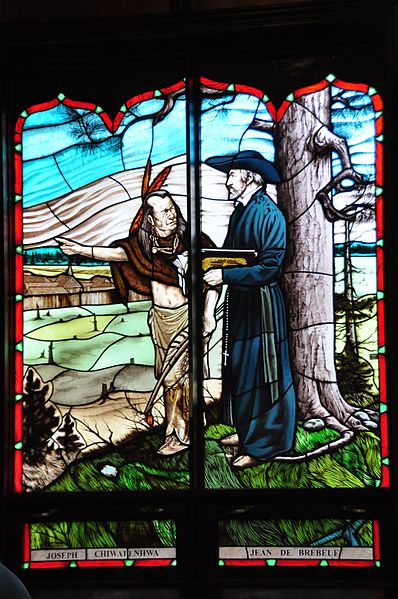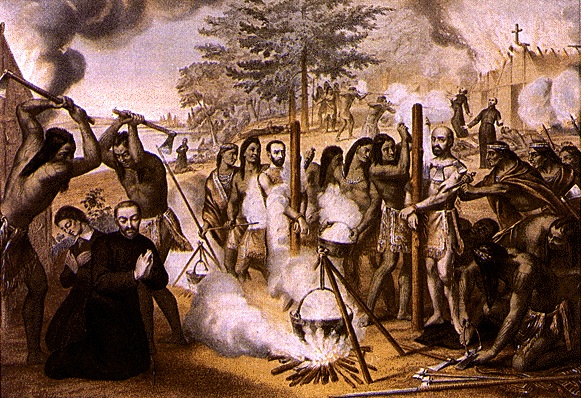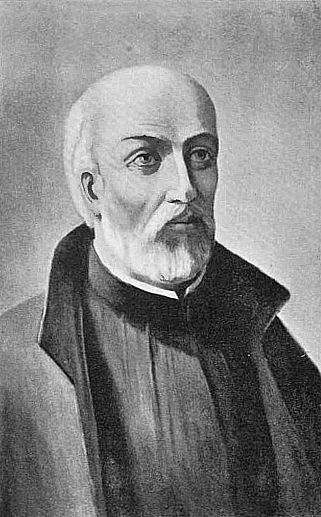On the morning of the twentieth, the Jesuits at Sainte Marie received full confirmation of the reported retreat of the invaders; and one of them, with seven armed Frenchmen, set out for the scene of havoc. They passed St. Louis, where the bloody ground was strewn thick with corpses, and, two or three miles farther on, reached St. Ignace. Here they saw a spectacle of horror; for among the ashes of the burnt town were scattered in profusion the half-consumed bodies of those who had perished in the flames. Apart from the rest, they saw a sight that banished all else from their thoughts; for they found what they had come to seek,—the scorched and mangled relics of Brébeuf and Lalemant.
The had learned their fate already from Huron prisoners, many of whom had made their escape in the panic and confusion of the Iroquois retreat. They described what they had seen, and the condition in which the bodies were found confirmed their story.

St. Jean de Brébeuf with the Huron (Stained glass) in Martyr`s Shrine in Midland, Ontario. Photo by Mykola Swarnyk.
On the afternoon of the sixteenth,—the day when the two priests were captured,—Brébeuf was led apart, and bound to a stake. He seemed more concerned for his captive converts than for himself, and addressed them in a loud voice, exhorting them to suffer patiently, and promising heaven as their reward. The Iroquois, incensed, scorched him from head to foot, to silence him; whereupon, in the tone of a master, he threatened them with everlatsting flames for persecuting the worshippers of God. As he continued to speak, with voice and countenance unchanged, they cut away his lower lip and thrust a red-hot iron down his throat. He still held his tall form erect and defiant, with no sign or sound of pain; and they tried another means to overcome him. They led out Lalemant, that Brébeuf might see him tortured.

The Jesuits martyrs of Canada: Jean de la Lande, Isaac Jogues, Jean de Brébeuf, Charles Garnier, René Goupil, Gabriel Lalemant, Noël Chabanel, Antoine Daniel.
They had tied strips of bark, smeared with pitch, about his naked body. When he saw the condition of his Superior, he could not hide his agitation, and called out to him, with a broken voice, in the words of Saint Paul, “We are made a spectacle to the world, to angels, and to men.” Then he threw himself at Brébeuf’s feet; upon which the Iroquois seized him, made him fast to a stake, and set fire to the bark that enveloped him. As the flame rose, he threw his arms upward, with a shriek of supplication to Heaven. Next they hung around Brébeuf’s neck a collar made of hatchets heated red-hot; but the indomitable priest stood like a rock. A Huron in the crowd, who had been a convert of the mission, but was now an Iroquois by adoption, called out, with the malice of a renegade, to pour hot water on their heads, since they had poured so much cold water on those of others. The kettle was accordingly slung, and the water boiled and poured slowly on the heads of the two missionaries. “We baptize you,” they cried, “that you may be happy in heaven; for nobody can be saved without a good baptism.” Brébeuf would not flinch; and, in a rage, they cut strips of flesh from his limbs, and devoured them before his eyes. Other renegade Hurons called out to him, “You told us that the more one suffers on earth, the happier he is in heaven. We wish to make you happy; we torment you because we love you; and you ought to thank us for it.” After a succession of other revolting tortures, they scalped him; when, seeing him nearly dead, they laid open his breast, and came in a crowd to drink the blood of so valiant an enemy, thinking to imbibe with it some portion of his courage. A chief then tore out his heart, and devoured it.
Thus died Jean de Brébeuf, the founder of the Huron mission, its truest hero, and its greatest martyr. He came of a noble race,—the same, it is said, from which sprang the English Earls of Arundel, but never had the mailed barons of his line confronted a fate so appalling, with so prodigious a constancy.
Francis Parkman, The Jesuits in North America in the Seventeenth Century (Boston: Little, Brown, and Company, 1897, 2:211–14.
Short Stories on Honor, Chivalry, and the World of Nobility—no. 839







